
Have you ever imagined combining the fierce loyalty of a Pitbull with the boundless affection of a Black Lab? Enter the Labrabull, a unique blend that’s making waves in the heart of dog lovers everywhere. This dynamic duo of dog breeds brings to life a companion that’s not just a pet but a heartwarming addition to families and homes. With their standout features and infectious personalities, the Pitbull mix with Black Lab isn’t just any dog—it’s a testament to the incredible results of mixing two beloved breeds.
Now, if you’re envisioning a four-legged friend with the bravery and strength of a Pitbull, paired with the gentle, friendly nature of a Black Lab, you’re spot on. But trust me, there’s a whole lot more to these adorable furballs. Whether you’re a dog enthusiast eager to learn more or you’re contemplating welcoming one of these mixed breeds into your life, you’re in for a treat. Let’s take a leisurely stroll through the life and times of the Labrabull, uncovering the ins and outs of their care, personality, and why they might just be the perfect new member for your family circle. Sit back, relax, and let’s get up close and personal with the Pitbull mix with Black Lab—your next potential furry family member!
You may also like: Silver Labs
Pitbull Mix with Black Lab (Labrabull) Overview:
| Aspect | Details |
|---|---|
| Breed Name | Labrabull (Pitbull Mix with Black Lab) |
| Size | Medium to Large (varies depending on dominant genes; typically 20-25 inches at the shoulder) |
| Weight | 50-90 pounds (again, can vary widely depending on the size of the parent breeds) |
| Lifespan | 10-14 years |
| Coat Type | Short to medium length, dense and sometimes glossy |
| Coat Color | Wide range, including black, white, brindle, chocolate, and combinations thereof |
| Temperament | Loyal, affectionate, energetic, intelligent. Can be protective of family but usually friendly. |
| Energy Levels | High; requires regular, vigorous exercise |
| Training | Highly trainable but requires consistent, positive reinforcement due to intelligence and energy |
| Socialization | Early socialization is crucial for good behavior with other pets and children |
| Health Issues | Generally healthy but can inherit issues from both breeds like hip dysplasia, heart problems |
| Nutritional Needs | High-quality dog food suited to the dog’s age, size, and energy level |
| Grooming Needs | Moderate; regular brushing due to shedding, occasional baths |
| Suitability | Best suited for active families, those with experience in dog training. Needs space to play. |
| Cost of Ownership | Varies; consider food, vet visits, grooming, training, and emergency health issues |
| AKC Recognition | Not recognized by the AKC as it is a mixed breed. Related breeds like the Labrador Retriever are recognized, but Pitbulls and their mixes are not. Alternative registries recognize mixed breeds. |
Table of Contents
- Origins and History
- Physical Characteristics of the Labrabull
- Temperament and Personality of the Labrabull
- Health and Lifespan of the Labrabull
- Care and Maintenance of the Labrabull
- Training and Socialization of the Labrabull
- Suitability as a Family Pet: The Labrabull in Various Living Situations
- Adoption and Rescue of Labrabulls
- Conclusion
- FAQs
Origins and History
The Labrabull, a mix between the American Pitbull Terrier and the Labrador Retriever, represents a fascinating blend of two breeds each with a rich and distinct heritage. Understanding the origins of the Labrabull requires a dive into the backgrounds of its parent breeds and the circumstances that led to the emergence of this mixed breed.
Background of the American Pitbull Terrier
The American Pitbull Terrier’s lineage can be traced back to the early 19th century in the United Kingdom, where they were bred from a mix of bulldogs and terriers. These dogs were originally used for bull-baiting and later for dog fighting, a testament to their strength, courage, and tenacity. However, it’s crucial to note that despite their fighting past, Pitbulls were also valued for their loyalty, intelligence, and gentle demeanor with humans. Immigrants brought these dogs to the United States, where they served as farm dogs, family protectors, and companions, gradually shaping the American Pitbull Terrier we know today.
Background of the Labrador Retriever
The Labrador Retriever traces its roots back to the early 19th century in Newfoundland, Canada. Originally called St. John’s dogs, after the capital city of Newfoundland, they were used by fishermen to help retrieve fishing nets and lost lines and occasionally catch fish that escaped from fishing lines. Labradors were bred for their strength, endurance, and excellent swimming ability. These traits, combined with their friendly nature and trainability, made them excellent hunting dogs. The breed was later brought to England, where it was refined and gained popularity as a sporting and hunting dog, eventually becoming one of the most beloved family pets worldwide.
Emergence of the Labrabull
The Labrabull mix likely originated in the late 20th century, as interest in mixed-breed dogs began to increase. This mix was not the result of a deliberate effort to create a new breed, but rather a natural consequence of the popularity of its parent breeds. Owners and breeders saw an opportunity to combine the protective and strong qualities of the Pitbull with the friendly and loyal nature of the Labrador.
The goal was to create a dog that embodied the best traits of both breeds: the intelligence, strength, and loyalty of the Pitbull, alongside the friendly, outgoing, and trainable nature of the Labrador. The Labrabull was thus born out of a desire for a versatile companion capable of fitting seamlessly into the role of a family pet, a working dog, or even a service animal, benefiting from the rich and varied histories of both its parent breeds.
As with many mixed breeds, the Labrabull’s history is not as well-documented as that of purebred dogs, and its development has been more organic. The mix has grown in popularity among dog lovers who appreciate the unique combination of traits that Labrabulls offer, embodying a living testament to the enduring appeal of both the American Pitbull Terrier and the Labrador Retriever.
Physical Characteristics of the Labrabull
The Labrabull, a striking mix between an American Pitbull Terrier and a Labrador Retriever, inherits a fascinating array of physical characteristics from both parent breeds. This blend results in a medium to large dog with a robust build, showcasing a blend of muscularity, agility, and grace. Let’s delve into the specifics of their size, coat, and color variations, along with the distinct physical traits they inherit from their lineage.
Size
Labrabulls are typically medium to large in size, with their weight and height reflecting the genetic contributions of both parents. On average, they can stand anywhere from 20 to 25 inches tall at the shoulder. Their weight is equally variable, generally ranging from 50 to 90 pounds, though some individuals may fall slightly outside these ranges depending on which parent’s genes are more dominant.
Coat
The coat of a Labrabull is one of its most distinctive features, often embodying the best of both breeds. They usually inherit the short, dense coat of both the Pitbull and the Labrador, making their grooming needs relatively manageable. The texture can vary from smooth to slightly coarse, with a lustrous sheen that speaks to their good health. Labrabulls are not considered hypoallergenic, and they do shed, especially during seasonal changes.
Color Variations
In terms of color, Labrabulls display a wide palette that can include black, white, brindle, chocolate, and various shades in between. This diversity is a direct reflection of the broad color range found in both the Pitbull and Labrador breeds. Some Labrabulls may also exhibit distinctive markings or patterns, such as patches or spots, further adding to their unique appearance.
Distinct Physical Traits
Labrabulls inherit a mix of physical traits from their parent breeds, resulting in a unique and sometimes unpredictable appearance. They often have the broad, muscular build of the Pitbull, combined with the sturdy, athletic frame of the Labrador. Their heads can be large and somewhat blocky, a trait from the Pitbull side, with expressive eyes that reflect the intelligence and warmth of both breeds. The ears tend to be of medium size, either flopping down like a Lab’s or semi-erect like a Pitbull’s.
One of the most charming aspects of the Labrabull is its tail. Inherited from the Labrador side, the tail is usually thick at the base and tapers to a point, known affectionately as an “otter tail.” This tail is a hallmark of their Labrador heritage and is often seen wagging energetically.
The Labrabull’s physical characteristics are a testament to the beauty and versatility of mixed-breed dogs. Each Labrabull is unique, with the potential to inherit any combination of traits from its parent breeds. This genetic diversity makes each Labrabull a one-of-a-kind companion, with a physical appearance as varied and interesting as their personalities.
Temperament and Personality of the Labrabull
The Labrabull, with its rich heritage from both the American Pitbull Terrier and the Labrador Retriever, boasts a temperament that is as multifaceted as its lineage. These dogs often embody a delightful mix of traits, including loyalty, intelligence, and an eagerness to please, making them excellent companions. Below, we explore the common temperament traits of the Labrabull, highlighting the unique blend of the protective nature of the Pitbull and the friendly demeanor of the Labrador, as well as the variability in temperament inherent to mixed-breed dogs.
Common Temperament Traits
Loyalty and Protective Instincts: From the Pitbull side, Labrabulls inherit a strong sense of loyalty and protective instincts towards their family. They are known to be incredibly devoted pets that will go to great lengths to ensure the safety and happiness of their loved ones. This protective nature doesn’t mean aggression; rather, it’s a testament to their deep bond with their family members.
Friendly and Outgoing: The Labrador’s friendly and outgoing nature is another dominant trait in Labrabulls. These dogs tend to be very sociable and enjoy the company of humans and other animals alike. They usually exhibit a joyful disposition, with a tail that’s almost always wagging. This friendliness makes them excellent family pets that can adapt well to various social situations.
Intelligence and Trainability: Both parent breeds are known for their intelligence, which the Labrabull inherits in spades. This intelligence, combined with a keen desire to please their owners, makes them highly trainable. They respond well to positive reinforcement and are capable of learning a wide range of commands and tricks.
Energy and Playfulness: Labrabulls are energetic and playful dogs that require regular exercise to stay happy and healthy. They love activities that engage both their mind and body, such as fetch, agility training, and long walks or runs. This high energy level is a trait they carry from both the athletic Labrador and the robust Pitbull.
Variability in Temperament
Due to their mixed-breed nature, Labrabulls can exhibit a wide range of temperaments, even within the same litter. The temperament of a specific Labrabull can lean more towards that of the Pitbull or the Labrador, or it can be a perfectly balanced mix of both. Factors such as genetics, socialization, training, and the individual dog’s experiences play a significant role in shaping their personality.
Socialization and Training: The importance of early socialization and consistent training cannot be overstated for Labrabulls. Exposure to different people, animals, and environments at a young age can help ensure that they grow up to be well-adjusted and friendly adults. Positive training methods that reinforce good behavior are crucial in nurturing their natural intelligence and eagerness to please.
In summary, the Labrabull’s temperament and personality make them well-suited to a variety of homes and lifestyles. Their protective nature, combined with their inherent friendliness, intelligence, and energy, creates a loving and loyal companion. However, prospective owners should be mindful of the variability in temperament and commit to providing the necessary training, socialization, and exercise to bring out the best in their Labrabull.
Health and Lifespan of the Labrabull
The Labrabull, a crossbreed between the American Pitbull Terrier and the Labrador Retriever, generally benefits from the hybrid vigor associated with mixed-breed dogs. This can often lead to a reduction in hereditary health issues. However, like all dogs, they are predisposed to certain health conditions inherited from their parent breeds. Understanding these health considerations is crucial for prospective and current Labrabull owners to ensure their furry friend leads a long, healthy life.
Genetic Health Issues
Hip and Elbow Dysplasia: Both Pitbulls and Labradors are prone to hip and elbow dysplasia, a condition where the joints do not fit together perfectly, which can lead to arthritis or lameness. Regular vet check-ups and maintaining a healthy weight can help manage this risk.
Heart Conditions: Labrabulls can inherit heart diseases like aortic stenosis (a narrowing of the aortic valve) from their parent breeds. Early detection through regular veterinary care can improve the outcome.
Skin Conditions: Pitbulls are known for their sensitive skin, prone to allergies and skin infections. Labrabulls may inherit this trait, requiring attention to their diet, grooming, and environment to prevent issues.
Eye Problems: Labrador Retrievers are susceptible to eye conditions such as progressive retinal atrophy and cataracts. Labrabulls could inherit these conditions, so regular eye examinations are recommended.
Exercise-Induced Collapse (EIC): Particularly from the Labrador side, Labrabulls might be at risk for EIC, a condition that causes weakness and collapse after periods of intense exercise. Awareness and monitoring during exercise can help manage this condition.
Average Lifespan and Influencing Factors
The average lifespan of a Labrabull is around 10-14 years, though this can vary based on several factors including genetics, overall health, and living conditions. Here are some factors that influence their health and longevity:
- Diet: A balanced, high-quality diet tailored to their size, age, and energy level is essential for maintaining good health.
- Exercise: Regular, moderate to vigorous exercise helps keep Labrabulls physically fit and mentally stimulated, reducing the risk of obesity and associated health problems.
- Preventive Care: Regular vet check-ups, vaccinations, and preventive treatments for parasites are crucial in catching and treating potential health issues early.
- Environment: A safe, stimulating environment that minimizes stress and provides plenty of social interaction can contribute to a longer, happier life.
Caring for a Labrabull requires a commitment to their health and well-being. Prospective owners should be prepared for the responsibility of managing the breed-specific health issues that may arise. With the right care, however, Labrabulls can be loving and loyal companions for many years.
Care and Maintenance of the Labrabull
Caring for a Labrabull, the unique blend of American Pitbull Terrier and Labrador Retriever, involves a comprehensive approach that addresses their nutritional, exercise, and grooming needs. These energetic and affectionate dogs thrive with attentive care, which not only enhances their quality of life but also fosters a deeper bond between pet and owner. Here’s what you need to know about the care and maintenance of your Labrabull:
Nutritional Needs and Feeding Guidelines
- Balanced Diet: A Labrabull requires a balanced diet rich in proteins, fats, carbohydrates, vitamins, and minerals. High-quality commercial dog food that suits their size, age, and energy level is typically recommended. Incorporating fresh, whole foods like vegetables and lean meats, as approved by your vet, can also contribute to their overall health.
- Feeding Schedule: Adult Labrabulls do well with two meals a day, while puppies may require three to four smaller meals as they grow. Consistency in feeding times helps regulate their metabolism and energy levels.
- Portion Control: It’s essential to follow feeding guidelines based on their weight and activity level to prevent obesity, which can exacerbate health issues like hip dysplasia. Regularly consulting with your veterinarian can help adjust their diet as needed.
Exercise Requirements
- Daily Exercise: Labrabulls possess a high energy level inherited from both parent breeds. They require at least an hour of exercise daily, which can include walks, runs, playtime, and mental stimulation exercises like puzzle toys or training sessions.
- Balanced Activities: A mix of physical activities and mental challenges keeps them physically fit and mentally sharp. Include activities that cater to their natural instincts, like retrieving games for the Labrador side and agility training for the Pitbull’s athleticism.
- Socialization: Exercise time is also an excellent opportunity for socialization. Introducing your Labrabull to new environments, people, and other dogs under controlled conditions can enhance their adaptability and behavior.
Grooming Needs
- Coat Care: Labrabulls typically have short to medium-length coats that are relatively low maintenance. Regular brushing, at least once a week, helps remove loose fur and distribute natural oils, keeping their coat healthy and reducing shedding.
- Bathing: They don’t require frequent baths—every few months or as needed when they get dirty. Using a gentle dog-specific shampoo will protect their skin from drying out.
- Nail Trimming and Ear Care: Regular nail trims prevent discomfort and mobility issues. Checking and cleaning their ears weekly can prevent infections, especially in dogs that love swimming or outdoor activities.
- Dental Health: Incorporating dental care into their routine, through brushing or dental treats, helps prevent gum disease and maintains overall health.
Providing proper care and maintenance for a Labrabull is a rewarding endeavor. These dogs, with their loyal and affectionate nature, return the love and attention they receive tenfold. Understanding and meeting their specific needs ensures a happy, healthy life together, filled with companionship and unconditional love.
Training and Socialization of the Labrabull
Training and socialization are crucial elements in raising a well-behaved and well-adjusted Labrabull. Given their heritage from the intelligent yet occasionally stubborn American Pitbull Terrier and the eager-to-please Labrador Retriever, Labrabulls present a unique blend of traits that make early socialization and consistent training imperative. Here’s how to navigate the training and socialization landscape for your Labrabull, ensuring they grow into a sociable, obedient companion.
Importance of Early Socialization and Consistent Training
- Early Socialization: Introducing your Labrabull to a variety of people, animals, environments, and experiences early in life helps them become more adaptable and less fearful in new situations. Socialization should start as early as puppyhood and continue throughout their life.
- Consistent Training: Consistency is key in training any dog, but especially so for breeds with a streak of independence. Establishing rules and sticking to them helps your Labrabull understand expectations and boundaries, fostering a respectful relationship between you and your pet.
Tips for Training a Labrabull
- Start Early: Begin training and socialization as soon as you bring your Labrabull home. Puppies are more receptive to learning, but older dogs can also learn with patience and consistency.
- Use Positive Reinforcement: Labrabulls respond well to positive reinforcement techniques such as treats, praise, and playtime. This method encourages them to repeat desired behaviors and strengthens your bond.
- Be Patient and Consistent: Patience and consistency are vital in training. If you’re working on a new command or behavior, stick with it. Changing commands or rules can confuse your dog and set back training progress.
- Address Stubbornness with Firmness and Kindness: If your Labrabull shows signs of stubbornness, maintain a firm yet gentle approach. Asserting leadership doesn’t mean being harsh; it’s about being consistent and fair in your commands and expectations.
- Socialize Regularly: Expose your Labrabull to different settings, sounds, people, and other animals in a controlled manner. Regular, positive experiences with the world outside can significantly reduce anxiety and aggression.
- Engage Their Mind: Labrabulls are intelligent dogs that thrive on mental stimulation. Include training exercises that make them think, like puzzle toys or obedience games, to keep their minds sharp and engaged.
- Enroll in Obedience Classes: Professional obedience classes can be a great way to socialize your Labrabull while reinforcing training techniques. These classes offer the added benefit of teaching you how to communicate effectively with your dog.
- Set Boundaries Early On: Teaching your Labrabull boundaries within the home and during walks is crucial. This includes leash training and commands like “sit,” “stay,” and “come,” which are essential for their safety and the safety of others.
Training and socializing a Labrabull is an ongoing process that requires time, effort, and a lot of love. These dogs are keen learners who often excel in various dog sports and activities, thanks to their versatile genetic makeup. By fostering their natural abilities and guiding them with a gentle, consistent hand, you can unlock the full potential of your Labrabull, making them not just a pet, but a cherished member of the family.
Suitability as a Family Pet: The Labrabull in Various Living Situations
The Labrabull, a blend of the American Pitbull Terrier and the Labrador Retriever, inherits a mix of traits that can make it an excellent family pet under the right conditions. Their adaptability, affectionate nature, and protective instincts can be a perfect fit for many households. However, their suitability for various living situations depends on several factors, including space, family dynamics, and the ability to meet their exercise and socialization needs. Let’s explore how Labrabulls fit into different family environments and what potential owners should consider.
Families with Children
Labrabulls are known for their affectionate and protective nature, qualities that can make them great companions for children. They often exhibit patience and a playful demeanor that matches well with the energy levels of kids. However, as with any large and energetic dog, supervision is crucial during interactions to ensure the safety of both the dog and the children. Teaching children how to approach and treat dogs respectfully is equally important.
Living with Other Pets
Thanks to the Labrador Retriever’s generally sociable nature, Labrabulls can get along well with other pets, especially when raised together or properly introduced. However, early socialization is key to fostering positive relationships with other animals, particularly given the Pitbull’s prey drive, which can vary in intensity from one Labrabull to another. Introductions should be done gradually and under controlled conditions to ensure harmony in the household.
Space Requirements
Labrabulls are medium to large dogs with high energy levels, meaning they thrive in environments where they have plenty of space to move and play. A home with a securely fenced yard is ideal. However, they can adapt to apartment living as long as their physical and mental exercise needs are met daily. This includes long walks, playtime, and interactive games to keep them engaged.
Housing Considerations
Prospective owners should also consider housing restrictions and insurance policies that may affect owning a Labrabull. Some regions and rental properties have breed-specific legislation or restrictions that could impact your ability to own a Labrabull. Additionally, homeowner’s insurance policies may have breed restrictions that include Pitbulls and their mixes.
Meeting Their Needs
The key to a harmonious household with a Labrabull lies in meeting their physical and emotional needs. A well-exercised, mentally stimulated Labrabull is more likely to be relaxed and well-behaved at home. Their need for companionship means they do best in environments where they are not left alone for long periods.
In summary, Labrabulls can make excellent family pets for households that can provide them with the space, exercise, and love they require. Their adaptable nature makes them suited to various living situations, from active singles to large families, as long as the commitment to their care and training is met. With the right preparation and understanding of their needs, a Labrabull can be a loving, loyal, and joyful addition to the family.
Adoption and Rescue of Labrabulls
Choosing to adopt a Labrabull rather than purchasing from a breeder can be a rewarding decision for both the dog and the adopter. Adoption offers a second chance at a loving home for many dogs in need, including Labrabulls, and can be an enriching experience. Below, we delve into the reasons why adopting a Labrabull might be preferable to buying one and provide resources for finding these special dogs a place in your heart and home.
Why Adopting is a Rewarding Option
Saving Lives: Adoption directly contributes to saving the lives of dogs in shelters and rescues. By choosing to adopt, you’re not only giving a Labrabull a much-needed home but also making room for other animals in need at the shelter.
Combatting Puppy Mills: Opting for adoption over purchasing from a breeder can help reduce the demand for puppy mills, which often prioritize profit over the well-being of the animals. Puppy mills are known for their poor living conditions and unethical breeding practices.
Cost-Effective: Adoption fees are generally lower than the cost of purchasing a dog from a breeder. Additionally, adopted dogs often come vaccinated, spayed or neutered, and microchipped, saving you on initial veterinary costs.
Supporting Valuable Resources: Adoption fees help support animal shelters and rescue organizations in their mission to care for and rehome pets. By adopting, you’re contributing to a system that helps countless animals in need.
Resources for Finding Labrabulls in Need of Homes
Local Animal Shelters: Start by visiting your local animal shelters. Shelters frequently house mixed breeds and can be a great place to find a Labrabull looking for a new home.
Breed-Specific Rescues: Some rescue organizations specialize in Pitbulls, Labradors, or their mixes. These rescues are familiar with the breeds and can help match you with a dog that fits your lifestyle. Examples include:
- Pit Bull Rescue Central: Offers resources and referrals to Pitbull rescues across the United States.
- Labrador Retriever Rescue: Focuses on rehoming Labradors and Labrador mixes.
Online Platforms: Websites like Petfinder.com and AdoptAPet.com allow you to search for adoptable dogs by breed, size, and location. These platforms can help you find a Labrabull in need of a home across various shelters and rescues.
Social Media and Online Forums: Joining breed-specific groups and forums on social media can connect you with communities dedicated to rehoming and rescuing Labrabulls. Members often post about dogs in need of adoption or foster care.
When considering adoption, it’s important to remember that the process may include an application, home checks, and meet-and-greets to ensure a good match between the dog and its new family. Adopting a Labrabull—or any dog—requires a commitment to their well-being, including their health, training, and emotional needs.
In choosing to adopt, you’re not just getting a pet; you’re gaining a loyal companion and providing a loving home to a dog in need. With patience and an open heart, adopting a Labrabull can be a deeply rewarding experience that enriches your life in countless ways.
Conclusion
Throughout our exploration of the Labrabull, a unique and affectionate blend of the American Pitbull Terrier and the Labrador Retriever, we’ve uncovered a wealth of information about their physical characteristics, temperament, health, and the special care they require. These dogs combine the best traits of their parent breeds, offering loyalty, intelligence, and an adaptable nature that can make them excellent companions for a wide variety of households.
Labrabulls are medium to large dogs known for their friendly and protective demeanor. Their need for regular exercise and mental stimulation, alongside their potential for being wonderful family pets, underscores the importance of active engagement from their owners. While they inherit a robust and generally healthy constitution, prospective Labrabull owners should be mindful of specific health concerns and the importance of regular veterinary check-ups.
Adopting a Labrabull, rather than purchasing one, can offer a fulfilling path to dog ownership, providing a loving home to a dog in need while supporting animal shelters and rescue organizations. The decision to bring a Labrabull into your life should be accompanied by a readiness to commit to their well-being, training, and socialization needs.
Owning a Labrabull comes with responsibilities that are rewarded with the unparalleled joy and companionship that these dogs bring. Their ability to integrate into the family as loyal and affectionate pets, coupled with their adaptability to various living situations, makes them a remarkable choice for the right household.
FAQs
Q: How much does a Labrabull puppy cost? A: The cost of a Labrabull puppy can vary widely depending on the source. Adopting from a shelter or rescue organization might cost anywhere from $50 to $400, covering basic medical care like vaccinations and spaying/neutering. Buying from a breeder, if you find one specializing in Labrabulls, could cost more, but it’s essential to prioritize reputable sources that ensure the health and well-being of their dogs.
Q: Are Labrabulls good with children? A: Yes, Labrabulls can be excellent with children, especially when raised with them or properly socialized. Their playful and protective nature makes them wonderful companions for kids. However, supervision is always recommended to ensure safe interactions between dogs and young children.
Q: Are Labrabulls good with cats? A: Labrabulls can get along with cats, particularly if they are raised together or properly introduced. Early socialization is key to promoting harmonious relationships between Labrabulls and other pets, including cats. Individual temperament and prey drive can vary, so it’s important to supervise initial interactions.
Q: Do Labrabulls require a lot of exercise? A: Yes, Labrabulls are energetic dogs that require regular, daily exercise to stay healthy and happy. Activities should include walks, play sessions, and mental stimulation to meet their physical and mental needs.
Choosing to welcome a Labrabull into your home means embarking on a journey filled with love, laughter, and the occasional challenge. In return for your commitment to their care and well-being, a Labrabull will offer you unwavering loyalty and companionship, making every moment spent together worthwhile.



